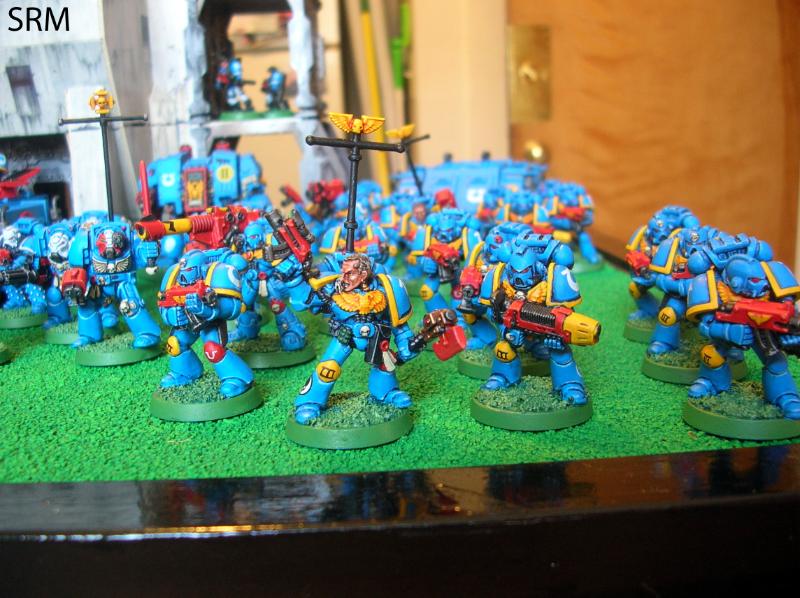Looking good for starters, mate. You clearly know what you're doing. A little rough at the moment no doubt, a few stray splashes of paint here and there but that's natural and it's nothing you won't overcome as you go.
As all ready suggested.
- Prime those bad boys. Makes the world of difference. Whether it's hand primed, or out of spray can, it don't matter, It's all good.
As you might well imagine priming a model black will give you a darker overall paint job. While priming white will do the reverse and as you might guess, priming with grey will give you a more neutral tone. It really depends on how you want your models to look.
The Ultramarines on the left, (painted by
Brother SRM) have most likely be primed white. This gives you a nice bright and vibrant colour. While the Ultramarine on the right (painted by
bubble) has probably been primed black. Giving it a much deeper colour.


As to what kind of primer to use? Well I use
The Army Painter colour primers. Easy to use. Nice colours. They go on well. I've used their black and white primer and I haven't had a problem with either. Games Workshop also sell something called "
Imperial Primer". I don't know if this is proper brush on primer or not, as I've not used it. But it could be an alternative. I know some people even use cans of auto-primers or even gesso to prime models with. It's all down to personal choice really.
- Before you even cut the models off the sprue give the whole thing a scrub in luke-warm soapy water. Helps the primer go on better. Some people will tell you don't bother washing it unless it's a resin model. I like washing the plastic models as well. I figured it only takes 10 minutes and if it helps achieve a better painted model, well then why not? You are spending good money on these things. Why not make them look as good as possible.
- Thin you paints. thin your paints. THIN YOUR BLOODY PAINTS!
Every one gets told this at some point or another and with good reason. Thinning paints can be very experimental at first. You have to figure out how much you need to thin individual paints down. Some colours like reds/whites/yellows don't need much while some like purples and black might need a lot. (This is just going off of my experience with the colours in question, mind. And is in no way a universal constant.) There are specialist paint thinners you can buy but plain old tap water will work just as good.
A word of caution. - Don't thin your paints in the paint pot. This is never a good idea. If you don't already then get yourself a palette of some description. An old plate will do. So will a ceramic wall or floor tile. You can also get plastic ones from stores and whatnot. Thin your paints on the palette. That way if you over thin well then you haven't potentially ruined a whole pot of paint.
As Kerrathyr said, find
your consistency. You hear people go on and on about paint needing to be the consistency of milk or like this or blah blah blah. Find the consistency you are happy painting with. Painting is very much a trial and error process. If you are happy with the way something looks then you stick with it. Don't let people tell you otherwise.
- Brushes.
What size brush are you using? It's good to have a range of different sized brushes for various tasks. Fine detail brush, base-coat brush, tank brush, etc. All good things to have.
- Brush water.
I'd advise having two pots of water for cleaning your brushes. 1 pot for metallic colours and 1 pot for non-metallic colours. Metallic paint leaves little flecks floating around in the water. These can stick on the brush and get transferred to other colour paints. This can leave your non-metallic paints looking kind of sparkly. It's certainly not the end of the world. But it can be bloody annoying seeing your nice clean, crisp blue armour looking like a vampire out of twilight.
You might even consider having 3 pots of water. 1 for metallics, 1 for dark paint and one for light paint. This might be a little over kill though unless you're constantly switching between light and dark colours. It's probably easier just to go and get fresh water.
On that note, it's good to replace your water often. How often is up to you. But I normally replace my water at the start of every painting session.
Honestly, the best advise is to just keep practising. It sounds a bit clichéd but it's true. You'll pick it up as you go.